James Cook in Hawaii
117 Explorations - Cook, James - Voyage dans l'hémisphère austral - Observations faites, pendant le second voyage de M. Cook... par M. Forster Paris, Hotel de Thou, 1778.
www.gazette-drouot.com 20240114
044c Priests traveling across Kealakekua bay for first contact rituals. Each helmet is a gourd, with foliage and tapa strip decoration. A feather surrounded akua is in the arms of the priest at the center of the engraving. It is not known what the purpose of the ritual surrounding first contact with Westerners was. Artist: John Webber, artist aboard Cook's ship. Scanned from page 20 of the following book:
Grant, Glenn (2004) Hawai`i Looking Back: An illustrated History of the Islands, Mutual Publishing, pp. 454pp
A rare set of four aquatints relates to Cook's Third Voyage. The watercolours from which these prints were engraved, were painted by James Cleveley, carpenter on HMS Resolution. According to the imprint on the aquatints, the original sketches were repainted by James's brother, John, in London. Cleveley died in 1786 and by the time his four watercolours were turned into aquatints by John Martyn two years later, changes had been made to the scene depicting Cook, far from trying to calm the situation, fighting the Hawaiians. See independent.co.uk (via wikipedia)
www.christies.com
, ,
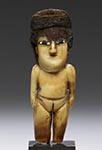 "Andean civilization is renowned for spectacular textiles that were at the heart of social politics and economics from earliest times. The fiber arts permeated all facets of daily existence, from clothing to protect the body to bridges spanning treacherous gorges. The form, materials, quality, and decorative imagery on clothing conveyed a person's social status or political affiliation and even recounted his or her specific accomplishments on behalf of the state. This female figure originally was dressed in clothing appropriate to her meaning as an offering - perhaps a building dedication cache or ritual deposit at a huaca, a sacred location where divine forces are concentrated. Coastal Andean peoples were keen observers of the vast ocean world. The Nazca, in particular, relied heavily on marine resources for food and materials for a variety of uses, such as the whale tooth from which this captivating lady was carved. The salty ocean and its unusual creatures constituted a dyadic opposition to the earth with its fresh waters. The carving of a ritual figurine from the tooth of a gigantic marine creature certainly carried extra spiritual significance. The authenticity of this figurine is now in question. Though the materials used are in keeping with those used by the ancient Nasca, recent discussions with scholars in the field in both United States and in Peru suggest that this type of figurine is not part of the known iconographic repertoire of the Nazca peoples of ancient Peru"
"Andean civilization is renowned for spectacular textiles that were at the heart of social politics and economics from earliest times. The fiber arts permeated all facets of daily existence, from clothing to protect the body to bridges spanning treacherous gorges. The form, materials, quality, and decorative imagery on clothing conveyed a person's social status or political affiliation and even recounted his or her specific accomplishments on behalf of the state. This female figure originally was dressed in clothing appropriate to her meaning as an offering - perhaps a building dedication cache or ritual deposit at a huaca, a sacred location where divine forces are concentrated. Coastal Andean peoples were keen observers of the vast ocean world. The Nazca, in particular, relied heavily on marine resources for food and materials for a variety of uses, such as the whale tooth from which this captivating lady was carved. The salty ocean and its unusual creatures constituted a dyadic opposition to the earth with its fresh waters. The carving of a ritual figurine from the tooth of a gigantic marine creature certainly carried extra spiritual significance. The authenticity of this figurine is now in question. Though the materials used are in keeping with those used by the ancient Nasca, recent discussions with scholars in the field in both United States and in Peru suggest that this type of figurine is not part of the known iconographic repertoire of the Nazca peoples of ancient Peru"
©: peruvian, possibly Nazca, Peru; CC The Walters Art Museum
tags: #nazca #peru #whale
ref. # 043a Pacific Ocean -Whale tooth female effigy figure
 "Andean civilization is renowned for spectacular textiles that were at the heart of social politics and economics from earliest times. The fiber arts permeated all facets of daily existence, from clothing to protect the body to bridges spanning treacherous gorges. The form, materials, quality, and decorative imagery on clothing conveyed a person's social status or political affiliation and even recounted his or her specific accomplishments on behalf of the state. This female figure originally was dressed in clothing appropriate to her meaning as an offering - perhaps a building dedication cache or ritual deposit at a huaca, a sacred location where divine forces are concentrated. Coastal Andean peoples were keen observers of the vast ocean world. The Nazca, in particular, relied heavily on marine resources for food and materials for a variety of uses, such as the whale tooth from which this captivating lady was carved. The salty ocean and its unusual creatures constituted a dyadic opposition to the earth with its fresh waters. The carving of a ritual figurine from the tooth of a gigantic marine creature certainly carried extra spiritual significance. The authenticity of this figurine is now in question. Though the materials used are in keeping with those used by the ancient Nasca, recent discussions with scholars in the field in both United States and in Peru suggest that this type of figurine is not part of the known iconographic repertoire of the Nazca peoples of ancient Peru"
"Andean civilization is renowned for spectacular textiles that were at the heart of social politics and economics from earliest times. The fiber arts permeated all facets of daily existence, from clothing to protect the body to bridges spanning treacherous gorges. The form, materials, quality, and decorative imagery on clothing conveyed a person's social status or political affiliation and even recounted his or her specific accomplishments on behalf of the state. This female figure originally was dressed in clothing appropriate to her meaning as an offering - perhaps a building dedication cache or ritual deposit at a huaca, a sacred location where divine forces are concentrated. Coastal Andean peoples were keen observers of the vast ocean world. The Nazca, in particular, relied heavily on marine resources for food and materials for a variety of uses, such as the whale tooth from which this captivating lady was carved. The salty ocean and its unusual creatures constituted a dyadic opposition to the earth with its fresh waters. The carving of a ritual figurine from the tooth of a gigantic marine creature certainly carried extra spiritual significance. The authenticity of this figurine is now in question. Though the materials used are in keeping with those used by the ancient Nasca, recent discussions with scholars in the field in both United States and in Peru suggest that this type of figurine is not part of the known iconographic repertoire of the Nazca peoples of ancient Peru"©: peruvian, possibly Nazca, Peru; CC The Walters Art Museum
tags: #nazca #peru #whale
ref. # 043b Pacific Ocean -'HMS Resolution and Discovery in Tahiti'
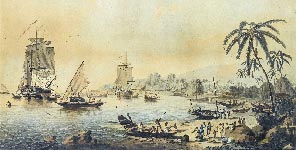 HMS Resolution and Discovery in Tahiti, commanded by James Cook -view of Morea, one of the Friendly Islands
HMS Resolution and Discovery in Tahiti, commanded by James Cook -view of Morea, one of the Friendly Islands"hand-coloured aquatints published by F. Jukes in 1787-88. 43 x 59cm (16 15/16 x 23 1/4in) (image size). This rare set of four aquatints relates to Cook's Third Voyage. The watercolours from which these prints were engraved were painted by James Cleveley, carpenter on HMS Resolution. According to the imprint on the aquatints, the original sketches were repainted by James's brother, John, in London. Cleveley died in 1786 and by the time his four watercolours were turned into aquatints by John Martyn two years later with changes to the scene made including."1787-1788
Author: John Martyn after John Cleveley the Younger (1747-1786)
©: Wikimedia commons, Source www.bonhams.com/auctions
tags: #HMS Resolution #HMS Discovery #James Cook #Tahiti
043d Captain Cook's death
'Death of Captain James Cook', oil on canvas by George Carter, 1783, Bernice P. Bishop Museum.
Wikipedia: BattleofKealakekuaBay.jpg
043e Artist : Johann Zoffany (1733–1810)
Title : The Death of Captain James Cook, 14 February 1779 Edit this at Wikidata
Description : English: The native is carrying a feather helmet and cloak that are in the Vienna museum (Zoffany borrowed them for the painting)
Depicted people James Cook
Date circa 1795
Medium oil on canvas
Dimensions height: 137.2 cm (54 in); width: 182.9 cm (72 in)
Collection : National Maritime Museum wikidata:Q1199924
Current location : Royal Museums Greenwich
Accession number : BHC0424
References: Royal Museums Greenwich artwork ID: 11916
Art UK artwork ID: the-death-of-captain-james-cook-14-february-1779-176213
Source/Photographer nmm.ac.uk
https://commons.wikimedia.org/wiki/File:Zoffany_Death_of_Captain_Cook.jpg
g
https://www.pastmasters.org.au/capt-cook---bad-hair-day.htmlg
ref. # 044 Pacific Ocean -Lau Hala hat
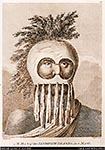 Tradition, Innovation, and Hawai´ian cultural identity in Lau Hala Papale (Hats)
Tradition, Innovation, and Hawai´ian cultural identity in Lau Hala Papale (Hats)Before the coming of the first foreigners to the islands in 1778, Hawai´ians wore hats, usually of conical shape, only when working in the sun for long periods. With the introduction to western clothing styles, Hawaiians became acquainted with and incorporated hats into everyday and special occasion attire. The tradition of making and wearing lau hala hats (papale) continues today. Dedicated master teachers (kumu) teach students (haumana) how to gather and prepare lau, then weave the lau into hats of both traditional and innovative styles. Most teaching takes place among family and friends, but several organizations have formed to ensure that the knowledge of lau hala weaving is passed on to future generations.
©: McDowellModule
tags: #Lau Hala hats #Hawaii
044a Pacific Ocean -South Seas fishhooks
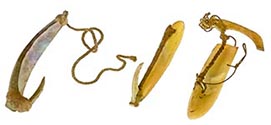 19th century; New Zealand, Tahiti and Hawaii
19th century; New Zealand, Tahiti and HawaiiBone, shell and twine. People living in the South Seas have created a large range of different fishhooks, each suited to catching a particular type of fish.
©: photo: Robert Schilder in Canterbury Museums and Galleries
tags: #canterbury #pacific
044b Pacific Ocean -Hawaiian sailors renew ties with Te Tai Tokerau
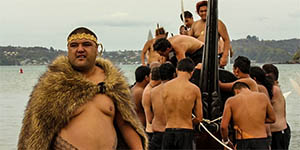 A bond formed almost 30 years ago between two Pacific peoples been renewed, the arrival of two voyaging canoes from Hawaii.
A bond formed almost 30 years ago between two Pacific peoples been renewed, the arrival of two voyaging canoes from Hawaii.The double-hulled waka Hokole'a and Hikianalia were formally welcomed at Waitangi on Saturday, one year into a four-year round-the-world voyage raising awareness of climate change and other threats to our oceans.
For many of those gathered on Tii Beach, however, the arrival meant more than any environmental campaign. Many were old enough to remember the Hokole'a's first visit in 1985, when it was the first waka of modern times to retrace the ocean routes of their Polynesian forefathers, using ancient navigation techniques based on the stars, sun and currents.
The Hawaiians' Voyage of Rediscovery sparked the Maori revival of traditional ocean voyaging, and inspired Doubtless Bay's Hekenukumai Busby to build the waka hourua (double-hulled canoes) that have now sailed every side of the Polynesian Triangle formed by New Zealand, Hawaii and Rapanui (Easter Island).
©: asked to share: www.nzherald.co.nz
tags: #hawaii #new zealand #pacific #maori #
Captain James Cook Relic
Could Human Hair & Scalp Tissue, pinned within an album of tapa cloth samples, be a relic of Cook's third Pacific Ocean voyage - that culminated in his death at Hawaii in 1779 ?Ethnographer & Tribal Art expert Arthur Beau Palmer is combing the clues to unlock the mystery.
# Extensive blog with many pictures!
www.pastmasters.org.au
ref. # 043b Pacific Ocean -'HMS Resolution and Discovery in Tahiti'
 HMS Resolution and Discovery in Tahiti, commanded by James Cook -view of Morea, one of the Friendly Islands
HMS Resolution and Discovery in Tahiti, commanded by James Cook -view of Morea, one of the Friendly Islands"hand-coloured aquatints published by F. Jukes in 1787-88. 43 x 59cm (16 15/16 x 23 1/4in) (image size). This rare set of four aquatints relates to Cook's Third Voyage. The watercolours from which these prints were engraved were painted by James Cleveley, carpenter on HMS Resolution. According to the imprint on the aquatints, the original sketches were repainted by James's brother, John, in London. Cleveley died in 1786 and by the time his four watercolours were turned into aquatints by John Martyn two years later with changes to the scene made including."1787-1788
Author: John Martyn after John Cleveley the Younger (1747-1786)
©: Wikimedia commons, Source www.bonhams.com/auctions
tags: #HMS Resolution #HMS Discovery #James Cook #Tahiti





